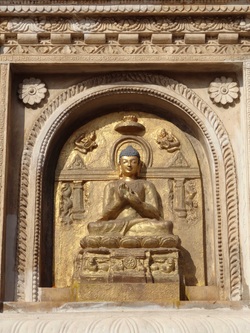
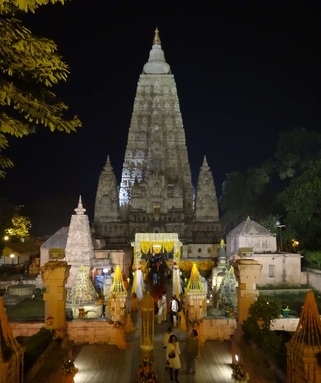
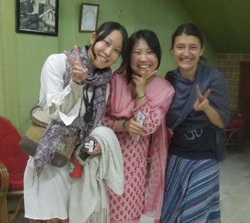
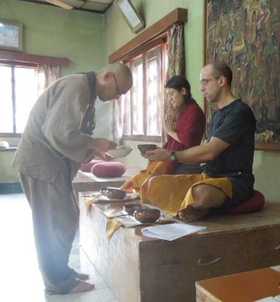
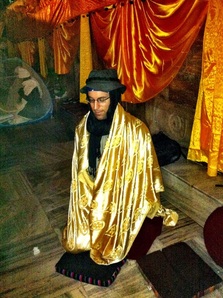
 Bodhgaya is widely considered the most important place in the world for Buddhism. It is here that Siddhartha Gautama sat down under a Bodhi Tree with the intention of not rising until he had seen the truth about existence. In the Zen tradition, it is said that he sat for 7 days and nights, steadfastly returning to the moment despite the distractions that his ego continuously produced. Then, as the sun rose on the 8th day, he had an experience of pure insight. He sat slack jawed as the nature of existence unfurled around him. For the first time, he saw clearly how everything in this world is beautifully impermanent, interconnected, and dependent on each other. Enlivened with his newfound experiential knowledge, a smile of gratitude curled his lips upwards and the new Buddha rose and began his walk to Sarnath, where he would find his previous companions and give his first teachings (see previous post).  Mahabodhi Temple When we arrived in Bodhgaya, we were excited about two things. Firstly, the opportunity to sit and meditate under the Bodhi tree as millions of Buddhist pilgrims have done before. Secondly, we were excited to explore the plethora of monasteries that have been built in Bodhgaya, particularly the Japanese Nippon-Ji Temple, since our own practice of Zen lies within a Japanese lineage. Upon arriving and finding a guesthouse, we headed to the Mahabodhi Temple Complex our first night. The Mahabodhi Temple is a beautiful tower-like stupa next to the Bodhi Tree that was first built by the Buddhist Emperor Ashoka in the 2nd century B.C.E. It was beautifully illuminated, rising sharply into the evening sky with its intricate carvings of Buddha and other symbolic figures. Behind it lay rooted the enormous Bodhi tree, a direct descendant of the original tree, whose massive leafy branches snaked out from the trunk in all directions. Under the green canopy of the tree sat pilgrims in meditation and prayer. Neda and I joined them and I instantly felt a powerful heart opening energy as we settled into the space. In just a few minutes, a group of Thai monks joined the group and their teacher began a teaching on the basics of mindfulness and the eightfold path. How wonderful to sit in this special place and listen to the dharma with other Buddhists!  Riko, Rika, and Neda The next day, we headed off to find the Japanese Monastery, having seen a flyer at dinner the night before advertising that they were practicing the Rohatsu sesshin there. Rohatsu is one of the most important holidays in the Zen tradition, when monks and lay people meditate for 7 days and nights like the Buddha did in the lead-up to Dec. 8th, the day of awakening. We arrived at the temple on the morning of the 5th, and were enthusiastically greeted by Rika, a staff member for the Soto Zen Association of Japan. They still had space for us to join them and were ecstatic that we had some previous experience in the Soto lineage. Strange as it may sound, many of the Japanese young people who had joined for the sesshin had never practiced Zen before, leaving us more amongst the most knowledgeable people of the forms of Soto Zen! Rika, Roshi Ogasawla (the head teacher), and Osho Toha, a priest who had come to assist in the sesshin, welcomed us to stay at the temple for the next 3 nights while we practiced with them.  Toha Osho serving us during oryoki Words can’t describe how warm their welcome was and how relieved Neda and I felt to find a connection to our own tradition in the tumultuous sea of emotions that had been stirred up while being in India. We joined them that very afternoon, sitting zazen, eating oryoki-style meals (formal meals eaten in the zendo), and even bathing Japanese style (sitting on little wooden benches to soap oneself before immersing in a warm tub) in the monastery's communal bathroom! There are 3 jewels customarily spoken of in Buddhism. The first is the Buddha himself, or the aspiration each being has of shedding delusion and finding awakening. The second is dharma, or living in accordance with truth in order to find awakening - this is where the teachings come into play. The final jewel is sangha, or the community of like-minded practitioners who support each other’s practice. For us arriving at Nippon-ji and finding such a welcoming sangha that we could seamlessly join was one of the highlights of our whole trip in India. And it led to very deep meditation as well. As we sat on our cushions, I had a variety of insights which I will share in words here the best I can. While meditating for a long time, I found myself swaying between drowsiness and lethargy on the one hand and distracted thinking on the other. While this is perfectly normal, it occurred to me that both of these states are like bottlenecks on our ability to be open to the fullness of experience in a given moment. If one can manage to sit between these two states in open awareness, the flow of experience is so rich that it makes thinking and sleeping look like shadows of reality, only capturing very limited amounts of what consciousness is capable of. But how can we find this place in the middle? Only by returning to the moment, to the breath, over and over again with as much patience and self-kindness as we can muster.  I also often thought of the Buddha and the great effort he must have put forth to find his own awakening under the tree. On the final night of the sesshin, our group moved from the monastery and did the meditation under the same Bodhi tree where the Buddha sat. As is traditional in the Soto lineage, you can choose to meditate for the whole evening of the final night as homage to the Buddha’s great effort. Neda and I decided to give it a try despite the swarming mosquitoes and dropping temperatures (see the picture of me bundled up with a blanket a fellow pilgrim gave me while under the tree to the left). After all, it was nothing compared to what the Buddha endured, right? Somehow the Buddha had settled his mind to the point that he saw interconnectedness not just as an analytical concept, but as reality itself. From this reality, he saw that as humans our best response to the enormous suffering in the world is to act from compassion and love in all that we do. In doing so, we free ourselves and we free others from the heavy burdens we all carry often without being aware of it. As the night passed, I felt tremendous gratitude not just to the sangha at Nippon-Ji who we had joined for this sesshin, but also for our community at the Missouri Zen Center and Austin Zen Center who have shared and supported this practice with us. I also felt a singular gratitude towards my incredible wife as she sat bundled up under the tree, her face set in deep concentration. Through our travels we have often only been a sangha of two, but two is a powerful number. In the end, the whole experience was like a spiritual booster shot. The warm smile of Osho Toha as he insisted on taking us to his favorite tent for black coffee and masala dosas, Rika’s invitation to come visit her in the mountains in Japan, and the camaraderie and friendship we found with Eric, Nari, Shin-shin, Shitoshi, Riko, and others who practiced with us. Since leaving Bodhgaya, we found our commitment to practice has been strengthened as we hold the three jewels close to our heart. Maybe we didn’t leave enlightened as the Buddha did, but certainly we felt lighter as we headed to our last stop in India, Kolkata. To see the rest of the pics of Bodhgaya click here. To see some pics of our time in Kolkata, exploring the remains of British colonialism at the Victoria Monument and Marble Palace while enjoying the relative calm of India’s only planned city, click here.
1 Comment
janep512
12/17/2012 10:03:53 pm
Wow. Marvelous to read your words and see the pictures of the place I've only read about. To be in the place that has such personal meaning...I can only imagine. Buddah, Dharma, Sangha. Safe travels to you both. Leave a Reply. |